Cagliari have undeniably been the surprise package of this Serie A season and are fifth, shadowing Roma in fourth. On Monday night, they led Lazio for almost 80 minutes before Lazio completed an injury-time comeback to win the game 2-1. That elevated Lazio to within three points of the top spot after Simone Inzaghi’s team have also started the season extremely well. This tactical analysis will look at the tactics used by both teams in the restless encounter in Sardinia.
Lineups
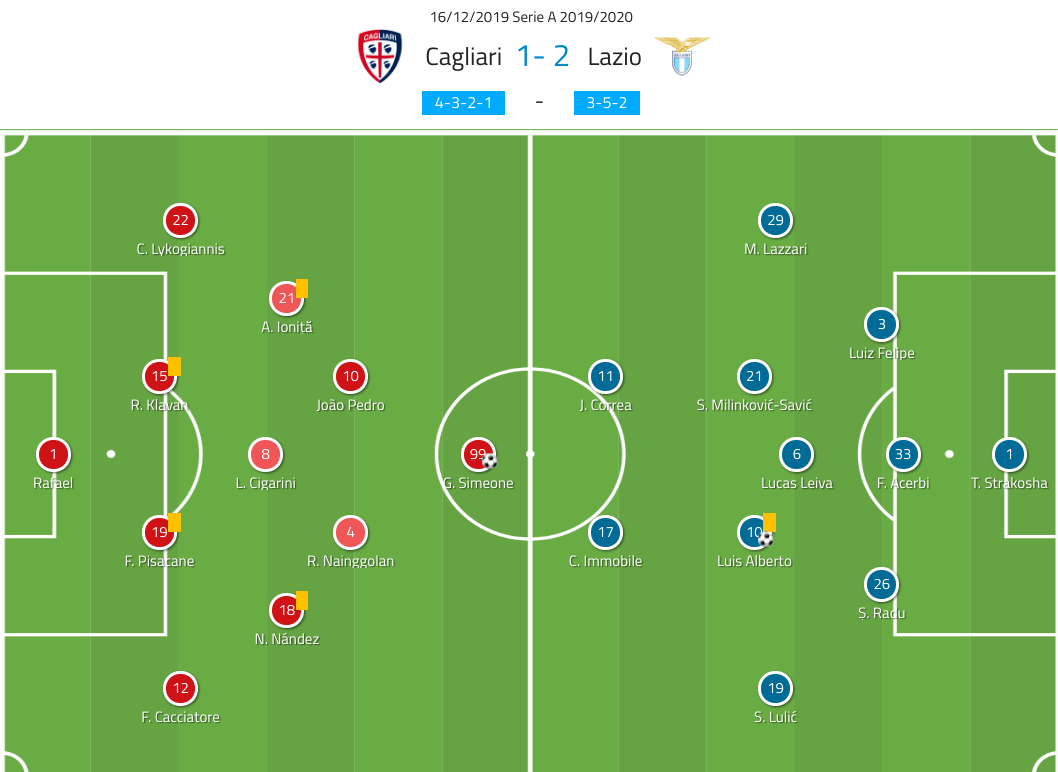
It was interesting to see how Rolando Maran lined his Cagliari team up in a shape that differed from their usual 4-3-1-2. Instead, Maran used João Pedro in a more withdrawn position alongside Radja Nainggolan with Simeone leading the line on his own. As we will see though, the front three’s positioning changed somewhat during the game.
Inzaghi organised Lazio in their usual 3-5-2/3-5-1-1 with Joaquín Correa playing slightly behind Ciro Immobile to create a midfield diamond at times with him at the tip, Sergej Milinković-Savić on the right, Luis Alberto on the left, and Lucas Leiva at its base.
Tactical analysis: Cagliari’s attacking play
As mentioned, Cagliari often set up in a 4-3-1-2 where Radja Nainggolan acts as the number 10 with the likes of Nahitan Nández, Marko Rog or Artur Ioniță on the sides of the diamond. For this game, Nández and Ioniță were used as the two outer central midfielders in Cagliari’s 4-3-2-1. As ever, Nainggolan often came deep for the ball and combined with Luca Cigarini in dictating Cagliari’s vertical passing style.
One key aspect of this vertical style of attacking was the deep runs made by Nández down the right. It was clear that Maran wanted the Uruguayan midfielder to exploit the gap between Ștefan Radu and Senad Lulić. Nández would repeatedly make runs into this channel and his teammates would always look to pick him out with deep passes into that area. In the image below, we can see how Nández leaves his position in midfield, gets away from Lulić and how Nainggolan picks him out down the right.
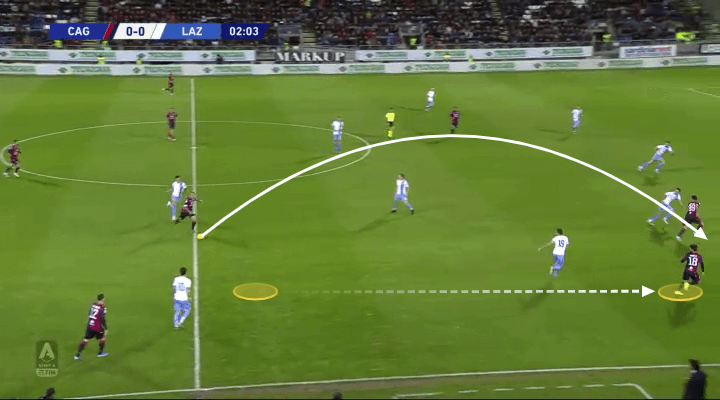
The image below highlights another situation when Nández makes a run behind the back of Lulić and the right-back Fabrizio Cacciatore releases him down the channel.
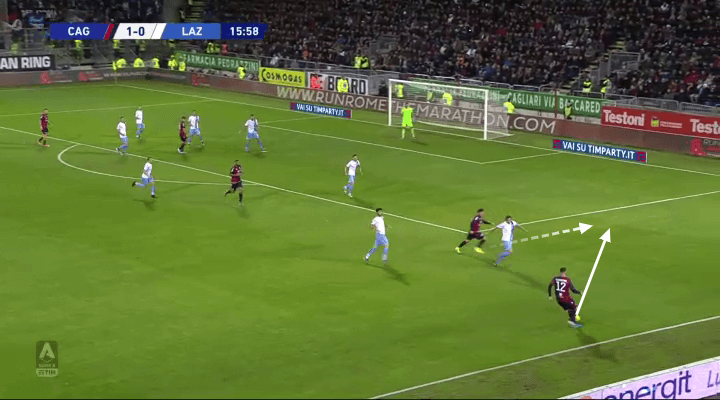
Whether as a number 10 or a right-sided attacking midfielder, Nainggolan is crucial to this team. He proved elusive for Lazio for long spells and found really good positions between the lines of Lazio’s defence and midfield. Thanks to the passing ability of Cigarini, who has consistently been one of Serie A’s best registi in the last decade, Cagliari could often progress the ball quickly from the base of their midfield to the attack. In the image below, Cigarini finds Nainggolan with a raking pass through the lines of Lazio’s midfield.
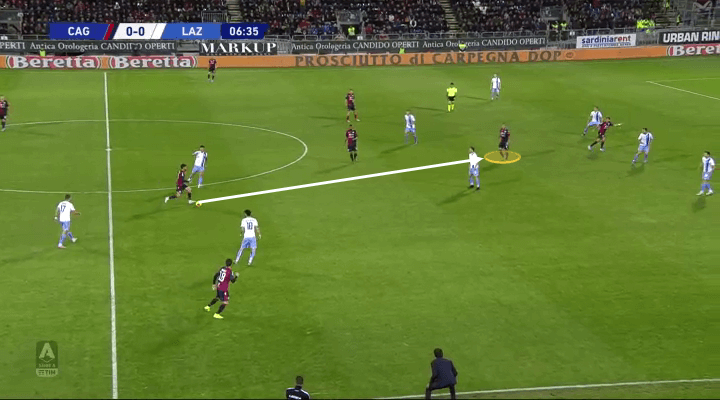
As mentioned, Cagliari’s nature in attack is very vertically focussed and they looked to cut through Lazio’s lines as quickly as possible. Nainggolan was key in this approach with his movement off the back of Leiva in particular. In the image below, we can see how Nainggolan makes a diagonal run from the right to receive Ragnar Klavan’s pass between the lines and then go on to play Giovanni Simeone through.
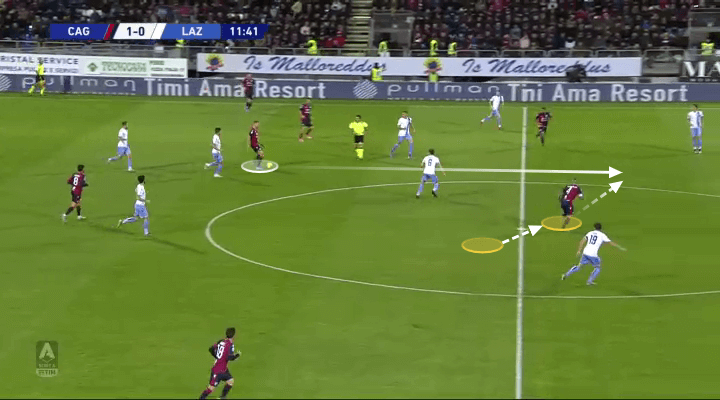
Cagliari’s attacking play was sharp and often very dangerous, but poor finishing at vital times ruined their chances of adding to their early lead.
Cagliari’s defensive setup
The main reason for Cagliari using a 4-3-2-1 in this game must have been certainly to get a numerical advantage in central midfield (5 vs 4) and to have straightforward pressing access to the three Lazio centre-backs. We can see Cagliari’s defensive shape in the image below, highlighting how narrow they were in order to prevent Lazio’s stunning central combination play, and instead force them wide.
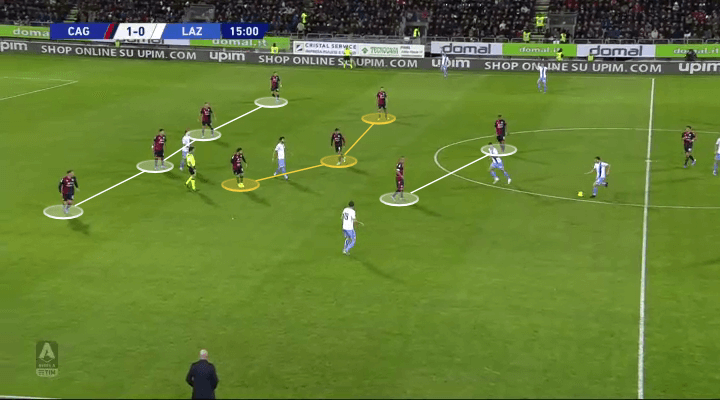
In the image below, we can see how Cagliari set up when looking to press Lazio. The front three had quite straightforward tasks but Simeone’s job was two-fold. Firstly, he needed to maintain access to press Francesco Acerbi, but also constantly use his cover shadow to prevent passes into Leiva, who otherwise would have been free to turn and play forward with the three central Cagliari midfielders deeper to deal with Lazio’s remaining three. Although Acerbi is one of Serie A’s best passers from defence, he cannot affect the game too much if he has no one to pass to. Simeone made sure Leiva’s influence was minimised and Cagliari could therefore stop Lazio’s build-up play quite well.
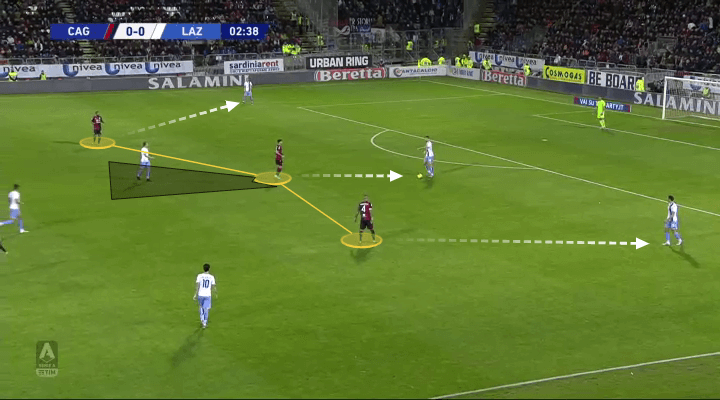
Cagliari’s shape was very narrow and they looked to make their team compact both horizontally and vertically. Since the aim was to force Lazio wide, they then had to overload around the ball when it eventually reached the wide areas. We can see this in the image below as Cagliari overload the space around the ball-carrier to minimise the space Lazio have to play in.
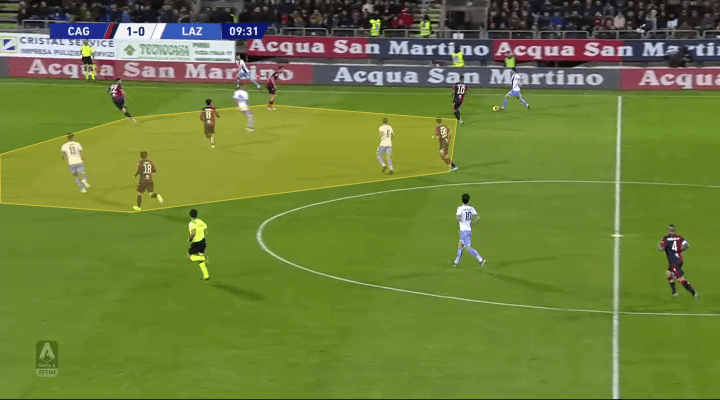
Again, in the image below we can see how compact and narrow Cagliari’s defensive shape was. This made it very difficult for Lazio to play in the central areas where they are so dangerous. However, as we will see below, Inzaghi had a plan for how to create chances anyway.
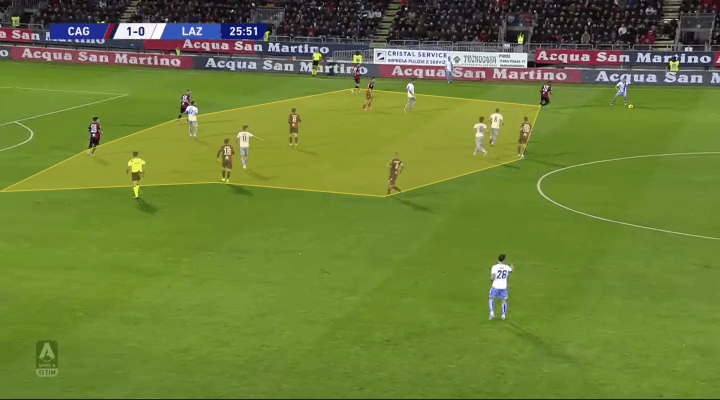
Lazio’s attacking solutions
Lazio are developing nicely into one of Europe’s most exciting teams to watch and the main reason for that is their devastating attack. So far this season, they are Serie A’s top scorers (joint with Atalanta on 38 goals) and it is easy to see why on the evidence of Monday night’s win. Since they were prevented from playing centrally, Inzaghi’s plan was to attack the wide areas with quick switches to isolate his wing-backs in 1 vs 1 situations and then fill the box with players to attack crosses.
Milinković-Savić played a key role in the switches from left to right in that he always made either runs in-behind to drag the left-back with him or just stood in that position to prevent the left-back from going out wide to Manuel Lazzari early. We can see this in the image below as the Serbian international (yellow) makes a diagonal run which means Lazzari is able to receive Leiva’s crossfield pass in plenty of space to then attack the full-back at pace.
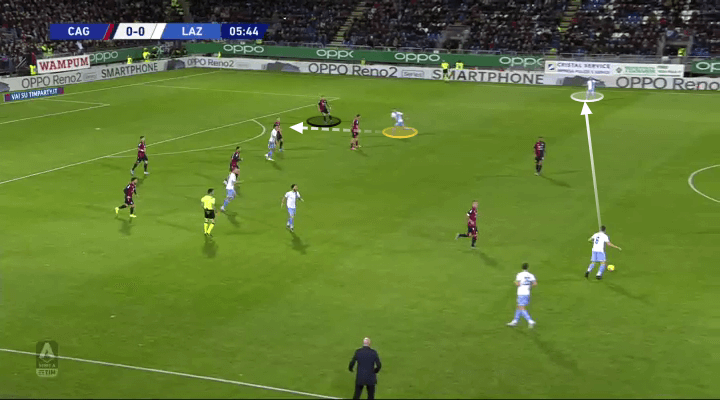
The image below highlights another situation where Lazio quickly switch sides to isolate Lazzari down the right.
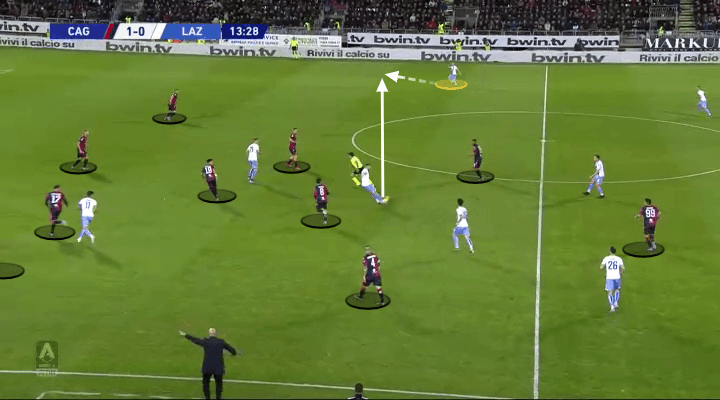
As Lazio searched for an equaliser in the second half, Inzaghi made some clever changes. Firstly, he tweaked the formation slightly to have Luis Alberto line up alongside Leiva deeper in midfield with Milinković-Savić and Correa as joint attacking midfielders behind Immobile in what was virtually a 3-2-4-1 in possession. We can see this setup in the image below. Secondly, he then brought on Jony to replace Lulić at left wing-back to get a natural left-footed crosser on that side. Thirdly, Danilo Cataldi replaced Leiva and offered some more aggression and energy in the latter stages to win the ball back quicker and, fourthly, Felipe Caicedo replaced Radu to play alongside Immobile.
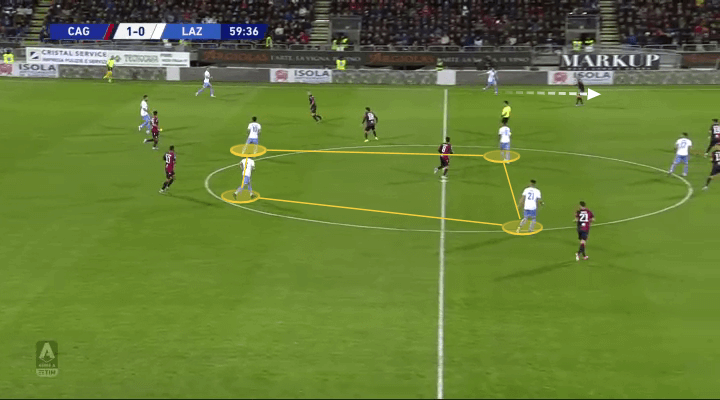
When the ball entered crossing positions, Lazio filled the box with at least four players and then usually had another two stationed just outside the box to win second balls and sustain attacks. In the end, it was no surprise that the 98th-minute winner came from a cross that was headed in by Caicedo.
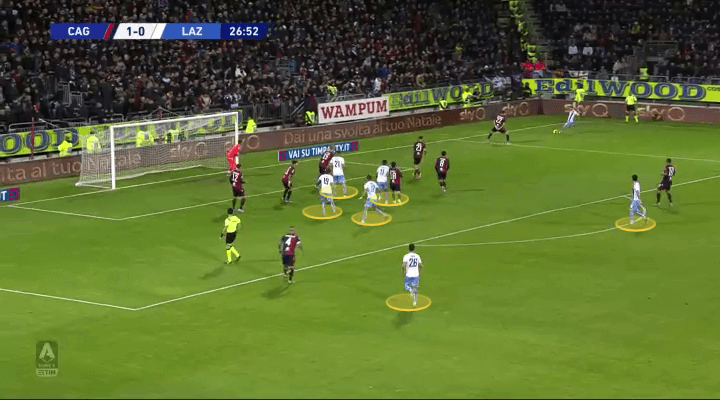
In the image above we can see Lazio’s setup to attack crosses.
Conclusion
As this analysis has shown, Cagliari really pushed Lazio close and came within a whisker of winning the game. However, Lazio’s late turnaround highlighted their mentality and quality, as well as Simone Inzaghi’s tactical understanding of when to change and who to bring on at the right time. That resulted in an impressive win for Lazio who continue to stay within reach of Inter and Juventus.

If you love tactical analysis, then you’ll love the digital magazines from totalfootballanalysis.com – a guaranteed 100+ pages of pure tactical analysis covering topics from the Premier League, Serie A, La Liga, Bundesliga and many, many more. Buy your copy of the December issue for just ₤4.99 here





Comments